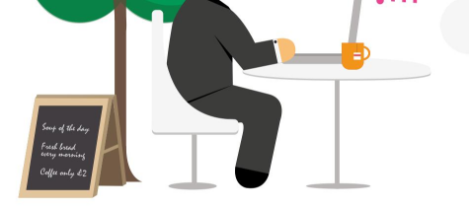July 28, 2016
Growing number of people past retirement age still work to boost income 0
 For all that everybody bangs on about Millennials, it’s increasingly apparent that the workforce in most nations is actually getting older and that it’s not just Governments who are keen to keep older staff in work, but also people themselves. A new study from MetLife based on Government data claims that nearly one in seven over-65s in the UK are boosting their retirement income by working, earning around £296 in addition per week. The data suggests that the numbers of over-65s working has increased from just 8 percent of the pensioner population to 13 percent in the last ten years, the equivalent of 1.1 million people. Median earnings from working are £296 a week adding up to annual pay of nearly £15,400. The need to keep working is underlined by the continuing squeeze on saving and investment income, which generates just £312 a year for pensioners on average. The proportion of pensioners earning money from investments has dropped from 72 percent in 2004/05 to around 64 percent now. Around 72 percent of all pensioners have private or company pensions compared with 66 percent a decade ago.
For all that everybody bangs on about Millennials, it’s increasingly apparent that the workforce in most nations is actually getting older and that it’s not just Governments who are keen to keep older staff in work, but also people themselves. A new study from MetLife based on Government data claims that nearly one in seven over-65s in the UK are boosting their retirement income by working, earning around £296 in addition per week. The data suggests that the numbers of over-65s working has increased from just 8 percent of the pensioner population to 13 percent in the last ten years, the equivalent of 1.1 million people. Median earnings from working are £296 a week adding up to annual pay of nearly £15,400. The need to keep working is underlined by the continuing squeeze on saving and investment income, which generates just £312 a year for pensioners on average. The proportion of pensioners earning money from investments has dropped from 72 percent in 2004/05 to around 64 percent now. Around 72 percent of all pensioners have private or company pensions compared with 66 percent a decade ago.











 According to new research from the Chartered Institute of Personnel and Development, the number of people saying that they have experienced mental health issues while in employment has climbed from a quarter to a third over the last five years. Despite this, the majority of employees still don’t feel that people experiencing mental health issues are supported well enough at work. In response, the CIPD is calling on organisations to take a more preventative approach to employees’ mental wellbeing, encouraging a culture of openness in their workplace, whilst at the same time, training line managers to provide and signpost support for employees, in order to create healthier, more engaged and more productive workplaces. The new research from the CIPD claims that in 2016, almost a third (31 percent) of the over 2,000 employees surveyed said they have experienced a mental health problem at some point during their working life, compared with a quarter (26 percent) in 2011.
According to new research from the Chartered Institute of Personnel and Development, the number of people saying that they have experienced mental health issues while in employment has climbed from a quarter to a third over the last five years. Despite this, the majority of employees still don’t feel that people experiencing mental health issues are supported well enough at work. In response, the CIPD is calling on organisations to take a more preventative approach to employees’ mental wellbeing, encouraging a culture of openness in their workplace, whilst at the same time, training line managers to provide and signpost support for employees, in order to create healthier, more engaged and more productive workplaces. The new research from the CIPD claims that in 2016, almost a third (31 percent) of the over 2,000 employees surveyed said they have experienced a mental health problem at some point during their working life, compared with a quarter (26 percent) in 2011.
 Two of the most persistent and related structural problems facing the UK economy are the productivity and digital skills gaps. Earlier this month, the Office for National Statistics reported that there had been a further 1.2 percent fall in productivity. Part of the reason for this is that there is an underlying digital skills gap. According to a report from Barclays, nearly a third (31 percent) of working-age adults in the UK lack even basic digital problem-solving skills which places the country comfortably below the 37 percent average across OECD countries. Despite this, a mere 38 percent of UK employers offer their workers digital skills training, perhaps because on the other side of the coin, the UK ranks highly in what the report calls ‘digital empowerment’, which it defines as ‘the ability and desire to use one’s digital skills to work productively and creatively, and to have the opportunity to continually upgrade them to keep pace with changing technology’.
Two of the most persistent and related structural problems facing the UK economy are the productivity and digital skills gaps. Earlier this month, the Office for National Statistics reported that there had been a further 1.2 percent fall in productivity. Part of the reason for this is that there is an underlying digital skills gap. According to a report from Barclays, nearly a third (31 percent) of working-age adults in the UK lack even basic digital problem-solving skills which places the country comfortably below the 37 percent average across OECD countries. Despite this, a mere 38 percent of UK employers offer their workers digital skills training, perhaps because on the other side of the coin, the UK ranks highly in what the report calls ‘digital empowerment’, which it defines as ‘the ability and desire to use one’s digital skills to work productively and creatively, and to have the opportunity to continually upgrade them to keep pace with changing technology’.
 Screening sporting events in the workplace may increase productivity, according to research released by employment law specialist Peninsula. In a survey of 894 employees across the UK, 64 percent reported being more productive as being allowed to watch sporting events at work. The survey, which claims to examine how businesses managed employees during the first half of the summer of sports also revealed that 46 percent of employees want clearer policies regarding watching sporting events at work. This related to the fact that employers only showed certain games during Euro2016 and didn’t show any of the Wimbledon tournament. 51 percent of respondents also called for employers to be more flexible during major sporting games allowing them to start late, leave early or swap with colleagues. 24 percent said that a lack of flexibility would encourage their decision to call in sick in order to watch their favourite sporting event.
Screening sporting events in the workplace may increase productivity, according to research released by employment law specialist Peninsula. In a survey of 894 employees across the UK, 64 percent reported being more productive as being allowed to watch sporting events at work. The survey, which claims to examine how businesses managed employees during the first half of the summer of sports also revealed that 46 percent of employees want clearer policies regarding watching sporting events at work. This related to the fact that employers only showed certain games during Euro2016 and didn’t show any of the Wimbledon tournament. 51 percent of respondents also called for employers to be more flexible during major sporting games allowing them to start late, leave early or swap with colleagues. 24 percent said that a lack of flexibility would encourage their decision to call in sick in order to watch their favourite sporting event.
 Working on complex tasks and work that is based on interactions with other people rather than data or things appear to protect against cognitive decline, according to research presented at the Alzheimer’s Association’s International Conference in Toronto. Researchers in two separate studies claim that people whose work requires complex thinking and activities are better able to withstand the wider causes of cognitive decline. The results suggest that working with people, rather than data or physical things, contributed the most to the protective effect and could offset the widely reported effects of a Western diet on cognitive ability. Researchers found that people with increased white matter hyperintensities (WMHs) – white spots that appear on brain scans and are commonly associated with Alzheimer’s and cognitive decline – could better tolerate WMH-related damage if they worked primarily with other people rather than with things or data.
Working on complex tasks and work that is based on interactions with other people rather than data or things appear to protect against cognitive decline, according to research presented at the Alzheimer’s Association’s International Conference in Toronto. Researchers in two separate studies claim that people whose work requires complex thinking and activities are better able to withstand the wider causes of cognitive decline. The results suggest that working with people, rather than data or physical things, contributed the most to the protective effect and could offset the widely reported effects of a Western diet on cognitive ability. Researchers found that people with increased white matter hyperintensities (WMHs) – white spots that appear on brain scans and are commonly associated with Alzheimer’s and cognitive decline – could better tolerate WMH-related damage if they worked primarily with other people rather than with things or data.


 A new study published to coincide with Smarter Working Day (today, apparently) claims that almost half of UK workers (48 percent) don’t think their current employee benefits package is tailored to their needs. The study of 1,000 UK workers published by payroll lending provider SalaryFinance claims that 38 percent of UK workers currently have access to flexible working although only 26 percent say they prefer the chance of flexible working to financial and psychological wellbeing benefits. Fewer than one in five (19 percent) currently have access to benefits designed to support mental wellbeing, such as counselling services, and only one in four (26 percent) receive financial wellbeing support from their employer. In contrast, one in three (32 percent) receive ad hoc incentives such as free lunches, birthday cakes and duvet days. With 58 percent of people saying that their employer has never asked for feedback on their benefits programme, employers could be falling out of touch with the needs of staff, claims the research.
A new study published to coincide with Smarter Working Day (today, apparently) claims that almost half of UK workers (48 percent) don’t think their current employee benefits package is tailored to their needs. The study of 1,000 UK workers published by payroll lending provider SalaryFinance claims that 38 percent of UK workers currently have access to flexible working although only 26 percent say they prefer the chance of flexible working to financial and psychological wellbeing benefits. Fewer than one in five (19 percent) currently have access to benefits designed to support mental wellbeing, such as counselling services, and only one in four (26 percent) receive financial wellbeing support from their employer. In contrast, one in three (32 percent) receive ad hoc incentives such as free lunches, birthday cakes and duvet days. With 58 percent of people saying that their employer has never asked for feedback on their benefits programme, employers could be falling out of touch with the needs of staff, claims the research.
 A rapidly ageing workforce is not just a challenge for Western economies. The government of China, the world’s second largest economy, has announced that it expects its workforce to decline by nearly a quarter (23 percent) between now and 2050 as the population ages and more and more jobs are automated. The Government is now considering raising the retirement age from 59 to 65 ahead of an anticipated sharp decline in the numbers of people of working age after 2030, according to the Ministry of Human Resources and Social Security. A spokesman for the ministry forecast a fall of 211 million people of working age to 700 million by 2050. China’s demographic challenge is mirrored in many countries but has its own characteristics thanks to its strict and controversial decades-long
A rapidly ageing workforce is not just a challenge for Western economies. The government of China, the world’s second largest economy, has announced that it expects its workforce to decline by nearly a quarter (23 percent) between now and 2050 as the population ages and more and more jobs are automated. The Government is now considering raising the retirement age from 59 to 65 ahead of an anticipated sharp decline in the numbers of people of working age after 2030, according to the Ministry of Human Resources and Social Security. A spokesman for the ministry forecast a fall of 211 million people of working age to 700 million by 2050. China’s demographic challenge is mirrored in many countries but has its own characteristics thanks to its strict and controversial decades-long 










